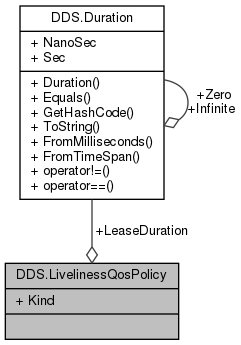 |
OpenSplice C# API
v6.x
OpenSplice C# Data Distribution Service Data-Centric Publish-Subscribe API
|
 |
OpenSplice C# API
v6.x
OpenSplice C# Data Distribution Service Data-Centric Publish-Subscribe API
|

Public Attributes | |
| LivelinessQosPolicyKind | Kind |
| Duration | LeaseDuration |
This QosPolicy controls the way the liveliness of an Entity is being determined.
| Value | Meaning | Concerns | RxO | Changeable |
|---|---|---|---|---|
| A LivelinessQosPolicyKind: kind | Determines the mechanism and parameters used by the application to determine whether an Entity is “active” (alive). The “liveliness” status of an Entity is used to maintain instance ownership in combination with the setting of the OWNERSHIP QoS policy. The application is also informed via listener when an Entity is no longer alive. The DataReader requests that liveliness of the writers is maintained by the requested means and loss of liveliness is detected with delay not to exceed the lease_duration. The DataWriter commits to signalling its liveliness using the stated means at intervals not to exceed the lease_duration. Listeners are used to notify the DataReader of loss of liveliness and DataWriter of violations to the liveliness contract. The kinds can be AUTOMATIC,MANUAL_BY_PARTICIPANT,MANUAL_BY_TOPIC The default kind is AUTOMATIC. | Topic, DataReader, DataWriter | Yes | No |
| A duration: lease_duration | Specifies the duration of the interval within which the liveliness must be reported. The default is infinite. | |||
| AUTOMATIC | The infrastructure will automatically signal liveliness for the DataWriters at least as often as required by the lease_duration | |||
| MANUAL | The user application takes responsibility to signal liveliness to the Service using one of the mechanisms described in LIVELINESS. Liveliness must be asserted at least once every lease_duration otherwise the Service will assume the corresponding Entity is no longer “active/alive.” | |||
| MANUAL_BY_PARTICIPANT | The Service will assume that as long as at least one Entity within the DomainParticipant has asserted its liveliness the other Entities in that same DomainParticipant are also alive. | |||
| MANUAL_BY_TOPIC | The Service will only assume liveliness of the DataWriter if the application has asserted liveliness of that DataWriter itself. |
This policy controls the mechanism and parameters used by the Service to ensure that particular entities on the network are still “alive.” The liveliness can also affect the ownership of a particular instance, as determined by the OWNERSHIP QoS policy.
This policy has several settings to support both data-objects that are updated periodically as well as those that are changed sporadically. It also allows customising for different application requirements in terms of the kinds of failures that will be detected by the liveliness mechanism.
The AUTOMATIC liveliness setting is most appropriate for applications that only need to detect failures at the process-level, but not application-logic failures within a process. The Service takes responsibility for renewing the leases at the required rates and thus, as long as the local process where a DomainParticipant is running and the link connecting it to remote participants remains connected, the entities within the DomainParticipant will be considered alive. This requires the lowest overhead.
The MANUAL settings (MANUAL_BY_PARTICIPANT, MANUAL_BY_TOPIC) require the application on the publishing side to periodically assert the liveliness before the lease expires to indicate the corresponding Entity is still alive. The action can be explicit by calling the assert_liveliness operations, or implicit by writing some data.
The two possible manual settings control the granularity at which the application must assert liveliness.
The value offered is considered compatible with the value requested if and only if the following conditions are met:
Changes in LIVELINESS must be detected by the Service with a time-granularity greater or equal to the lease_duration. This ensures that the value of the LivelinessChangedStatus is updated at least once during each lease_duration and the related Listeners and WaitSets are notified within a lease_duration from the time the LIVELINESS changed.
Definition at line 1322 of file DdsDcpsStructs.cs.
| LivelinessQosPolicyKind DDS.LivelinessQosPolicy.Kind |
Definition at line 1324 of file DdsDcpsStructs.cs.
| Duration DDS.LivelinessQosPolicy.LeaseDuration |
Definition at line 1325 of file DdsDcpsStructs.cs.